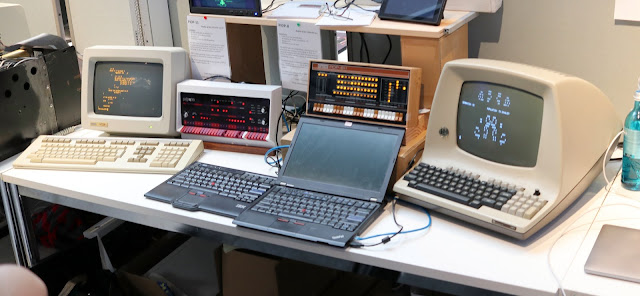Available April 2012
Single board computers were common in the early days of microcomputers, with the KIM-1 offering a relatively low-cost way of playing with the then-new 6502 CPU and later devices such as the Acorn System 1 made it cheaper still. But single board computers appealed most to hobbyists, and as technology developed so did microcomputers, eventually evolving into complete systems that were easier for novices to use.
 |
| Original Raspberry Pi Model B |
As the decades rolled on, the amount of computing power that could be squeezed into a board computer grew. First came Arduino, a series of open source board computers that could be used for microcontrollers. A few years later, TI came up with the BeagleBoard which was a general purpose computer on a single board. But perhaps the best know modern single board computer is the Raspberry Pi, shipping to customers in April 2012.
Unlike some other designs, the Pi was a complete system on a compact board. With built-in USB, video and networking ports all that was required was a memory card with an operating system and a monitor, keyboard, mouse and power supply. These are all pretty common peripherals, and in most cases Pi users could just re-purpose old equipment used elsewhere. The Pi didn’t come with a case so a cottage industry started up making them, all of this echoing the rather do-it-yourself approach of the original Apple I.
The first Raspberry Pi models were announced in February 2012, coming to market in April the same year. Like the BBC Micro, there were two launch models of the Pi – A and B. B was the most popular, based around a Broadcom chipset that included an ARM CPU, RAM and all of the other silicon needed on a single chip. But perhaps the biggest breakthrough was the price – this complete computer system cost just $25 or the local equivalent for the simplest model.
Coincidentally, the ARM CPU in the Pi was originally designed by Acorn, whose experience with the 6502 (starting with the Acorn System 1 board computer) inspired them to create an inexpensive, simple but very fast processor based on similar principles.
The target market was initially education – instead of expensive laptops, students could simply plug their own Pi into a PSU, monitor, network socket, mouse and keyboard and do whatever they wanted with it. The easily swappable memory card meant that different configurations could be experimented with easily. But the appeal turned out to be far greater, everyone from hobbyists to engineers wanted to play with one and the Pi became a significant success. Raspberry Pi devices can be seen in almost any application from controllers to servers, often performing tasks as well as machines costing hundreds of times as much.
A decade on, the Raspberry Pi is still going strong. Later models offered more ports, a faster processor and more memory and even cheaper models such as the Pi Zero and Pi Pico slotted into the range below the fully-featured Pi. A wide range of peripherals are available for almost any application, and OS support has grown from Linux-only to include Windows 10 IoT and even a version of RISC OS (originally designed for the very first ARM-based computer, the Archimedes).
 |
| Raspberry Pi emulating a DEC PDP-8 and PDP-11 |
Millions of devices and a decade later, the Pi has proved to be an antidote to the anodyne world of modern personal computing. The Pi helped to re-ignite some of the early hacker ethic of early micros and taught a new generation that what they could do with a computer was only limited by their imagination. Not too shabby for just $25.
Image credits:
osde8info via Flickr – CC BY-SA 2.0
Wolfgang Stief via Flickr – CC0

No comments:
Post a Comment